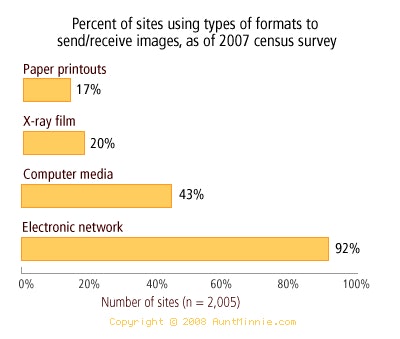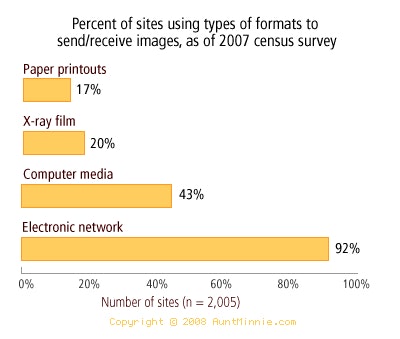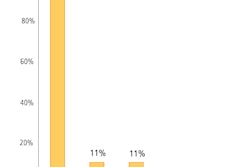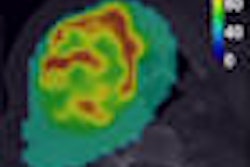
Patient treatment visit volume at radiation oncology sites edged upward at a single-digit rate in the U.S., even as new technology is changing the way radiation therapy is delivered, according to a new report published by market research firm IMV Medical Information Division of Des Plaines, IL.
The total number of treatment visits in 2007 was 24.5 million, up 5% over 2006. While the overall number of patients treated with radiation therapy is relatively stable, radiation oncology providers are increasing their expenditures for capital equipment, according to Lorna Young, senior director of market research at IMV.
"Close to one-third of the sites surveyed by IMV have capital budgets of $1.5 million or more planned for 2008, compared to 15% of the sites in 2003," she said. "And, for those with capital budgets, the average 2008 budget is estimated to be $1,775,000, up 30% from an estimated $1,365,000 in 2007."
What's fueling the increase in capital expenditures in radiation therapy departments? Young speculated that the radiation oncology providers are retooling their facilities, with many radiation oncology centers moving either to new or significantly renovated quarters.
"While the number of patients treated with radiation therapy every year is relatively stable, at around 954,000, the technological sophistication of radiation oncology departments is continuing to advance," Young said. "Digital imaging has become integrated into treatment planning for guiding tumor treatment in real-time."
For example, more than half of the radiation oncology sites provide treatment using image-guided radiation therapy (IGRT), up from 15% of the sites in 2004, using either a dedicated IGRT imaging device or electronic portal imaging, she said. Ultrasound, x-ray, and CT are the primary imaging modalities used in IGRT.
Image-guided radiation therapy provides a real-time ability to guide treatment with images taken while the patient is in the treatment room; it is most useful in situations where tumors might shift in position relative to the beam, such as when the patient breathes, or when immobilization may change from day to day, such as with prostate cancer, given physiologic changes in surrounding structures.
Providers are updating their facilities to integrate technology that improves their ability to see, plan, and treat cancer. Almost all of the radiation oncology sites utilize CT images to accurately visualize tumor location. By knowing exactly where the cancer is, sites can build treatment plans to help minimize the effects of the radiation therapy on healthy tissue while targeting the cancerous tissue, Young said.
While MR and PET are used to a lesser extent, some centers do utilize these imaging modalities. Treatment planning that incorporates PET is being used in 11% of centers, with separate CT and PET scan datasets fused with software applications. Alternatively, images are captured on hybrid PET/CT scanners.
 |
Technologic advances in the electronic management of data have also been part of the retooling process. Having a robust electronic image management network has become necessary for the efficient communication and use of these images. Five years ago, approximately 60% of radiation therapy sites were using PACS networks to manage the images used in treatment plans, but the IMV survey reveals that 92% have now adopted this technology to improve workflow and enhance patient management.
 |
More than 90% of the simulators being installed are now CT simulators, as opposed to the traditional x-ray-only simulators, the report also revealed.
Another treatment technique often used in tandem with IGRT is intensity-modulated radiation therapy (IMRT), and the IMV report suggests that growth in IMRT utilization has increased to 87% of radiation oncology sites offering the capability. In the beginning of the decade, that number was just under a quarter of sites.
The top three cancers treated with radiation therapy are prostate (21%), breast (20%), and lung (13%), and IMRT is a key tool in the treatment of prostate, head and neck, breast, thyroid, and lung tumors because it is capable of delivering maximum dose to tumor tissue while sparing healthy structures in proximity.
IMV's latest radiation oncology survey was conducted in 2007 and 2008 via telephone interviews with 652 radiation oncology sites, and the results were projected to the 2,100 U.S. hospitals and nonhospitals where radiation treatments are performed.
By Cheryl Hall Harris, R.N.
AuntMinnie.com contributing writer
August 28, 2008
Disclosure notice: AuntMinnie.com is owned by IMV, Ltd.
Related Reading
MRI procedure growth rate slows, study shows, June 5, 2008
PET drives growth in nuclear medicine market, April 30, 2008
Nuclear medicine market nears $300 million, February 26, 2008
Study: DR catalyst for European x-ray market, January 25, 2008
Report: Nuclear medicine patient visits drop in 2006, October 16, 2007
Copyright © 2008 AuntMinnie.com



















